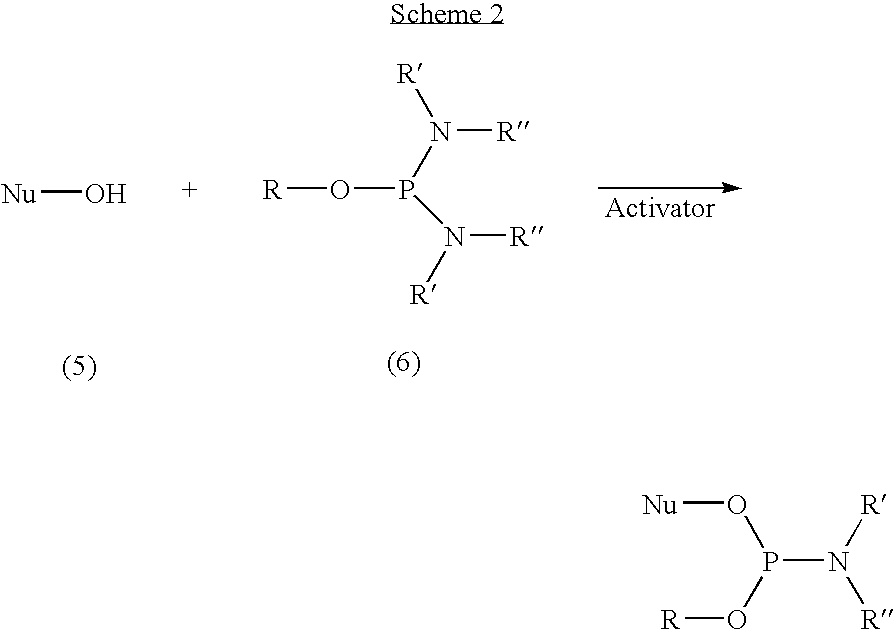Activators for oligonucleotide and phosphoramidite synthesis
a technology of phosphoramidite and oligonucleotide, which is applied in the field of nucleotide and oligonucleotide chemistry, can solve the problems of increasing the cost of routine applications, high risk of synthesis failure, and particularly high risk
- Summary
- Abstract
- Description
- Claims
- Application Information
AI Technical Summary
Benefits of technology
Problems solved by technology
Method used
Image
Examples
example 1
Solubility and Acidity of 5-Substituted 1H-tetrazoles
[0092] Solid tetrazole derivatives (0.5 to 2 mmol) were incubated with acetonitrile (1 ml) at 25° C. in a shaker equipped with a thermostat overnight to result in saturated solutions of tetrazole derivatives which contained residual undissolved solid material. The suspensions were left without shaking at 25° C. until the solid material settled completely. An aliquot of the respective solutions (0.50 ml) was separated from the solid material and diluted with a mixture of acetonitrile and water (1 / 1, v / v, 20 ml). The resulting solution was titrated with NaOH solution (0.100 M, 10 ml) while the pH was measured with a glass electrode. The pH was recorded against the consumption of NaOH solution and the solubility and the pKa-value of the respective tetrazole derivative were calculated from the inflexion points of the corresponding titration curve. The results are set forth in Table 2.
TABLE 2Solubility and acidity of 5-substituted 1...
example 2
Miscibility of Activator Solutions with Deblock- and Capping-Solutions
[0093] Solutions of tetrazole derivatives in acetonitrile were mixed with either deblock solution (3% trichloroacetic acid in dichloromethane, w / v), a mixture of Cap A and Cap B solution (1 / 1, v / v, Cap A=10% acetic anhydride in THF (v / v), Cap B=10% pyridine plus 10% n-methylimidazole in THF (v / v)), or a mixture of Fast Cap A and Cap B solution (1 / 1, v / v, Fast Cap A=5% (4-tert-butylphenoxy)acetic acid anhydride in THF (w / v), Cap B=10% pyridine plus 10% N-methylimidazole in THF (v / v)) in ratios of 1 / 9, 1 / 1 and 9 / 1, v / v. The resulting mixtures were visually inspected for the presence of precipitates. The results are set forth in Table 3.
TABLE 3Miscibility of activator solutions with deblock- and capping-solutionsActivator solution,acetonitrile as solventmixed withobservation0.45 M 1H-TetrazoleDeblockclear solutionCap A + Cap Bclear solutionFast Cap A + Cap Bclear solution0.5 M 4,5-DicyanoimidazoleDeblockratio 9 / 1:...
example 3
Synthesis of the DNA Homosequence Oligonucleotide dT10 (16) (SEQ ID NO:13)
[0094] The DNA oligonucleotide sequence dT10 was synthesized using an ABI Expedite™ Model 8909 DNA / RNA synthesizer with commercial DMT-dT-phosphoramidite and commercial deblock-, capping- and oxidizer synthesis solutions at 1 μmol scale on a CPG 500 support. A 0.1 M solution of 5-(3,5-bis(trifluoromethyl)phenyl)-1H-tetrazole (8) was employed as activator solution. The synthesis was performed using the standard DNA synthesis protocol supplied by the manufacturer of the synthesizer in DMT-OFF mode. The oligonucleotide was cleaved from the support with 1 ml conc. aqueous ammonia (32%) for 45 minutes at room temperature and further incubated in the ammonia solution at 55° C. for 16 hours. The solution was cooled on ice and evaporated under vacuum centrifugation. The residue was dissolved in water and an aliquot was analyzed by anion-exchange HPLC on a Dionex DNAPac PA100 column (4×250 mm) eluting with a linear gr...
PUM
| Property | Measurement | Unit |
|---|---|---|
| Temperature | aaaaa | aaaaa |
| Time | aaaaa | aaaaa |
| Dissociation constant | aaaaa | aaaaa |
Abstract
Description
Claims
Application Information
 Login to View More
Login to View More - R&D
- Intellectual Property
- Life Sciences
- Materials
- Tech Scout
- Unparalleled Data Quality
- Higher Quality Content
- 60% Fewer Hallucinations
Browse by: Latest US Patents, China's latest patents, Technical Efficacy Thesaurus, Application Domain, Technology Topic, Popular Technical Reports.
© 2025 PatSnap. All rights reserved.Legal|Privacy policy|Modern Slavery Act Transparency Statement|Sitemap|About US| Contact US: help@patsnap.com



